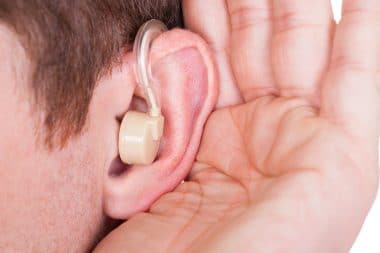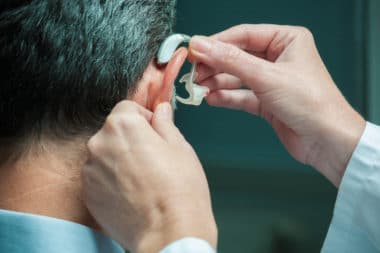Loss of hearing can be a very scary experience, especially if it happens suddenly. Your hearing capacity is most commonly affected by advancing age, injuries or accidents, and stress caused by listening to loud noises. Infections, thankfully are not considered to be the leading cause of permanent hearing loss. But infections in the middle ear and inner ear can lead to a temporary hearing loss. And they are quite common, especially among children. Young kids suffer from ear infections more often than adults. Though often easily treated with medication, if you neglect it for too long, it may lead to serious complications including permanent hearing loss.
Anatomy Of The Ear
To better understand the impact of infections of your ears, a brief look at the anatomy of the human ear is necessary. Your ear is broadly made up of three main parts. They are the outer ear, middle ear, and inner ear.
Outer Ear:
- Outer Ear: this is the visible part of the ear. It includes the outer fleshy area called the pinna, as well the ear canal. The outer ear is separated from the middle ear by the walls of the eardrum. It is the main route through which sounds and noises are fed to your inner ear.
Middle Ear:
- Middle Ear: this part connects the outer ear to the inner ear. It sits around 1.5 inches inside your ear, and has the eardrum, several small bones called ossicles, ligaments, and several air-filled chambers called “windows.” Its main job is to amplify and carry the sounds coming through the ear canal to the inner ear. The middle ear is also connected to your throat through an opening called the Eustachian Tube. This tube is a common site of viral and bacterial infections. Middle ear transmits to the inner ear through the chamber called “oval window.”
Inner Ear:
- Inner Ear: This is the part which helps you “hear” sounds. It contains the cochlea, which converts sound vibrations into electrochemical signals which are transferred to your brain by the auditory nerve. The inner ear is also responsible for helping to maintain your balance when standing up and moving, thanks to a system called the “vestibular system.” The inner ear is made up of bony passages and fluid filled cavities. Infections in this area are primarily caused by viruses and can cause permanent hearing loss.
Types Of Hearing Loss
There are two main ways in which hearing loss can occur. They are:
Sensorineural Hearing Loss:
- Sensorineural Hearing Loss: This is usually the more severe and often, permanent hearing damage. It involves both age-related hearing loss as well as hearing loss due to physical injuries to the inner ear. Some rare medical conditions and viral infections can also cause damage to the inner ear and lead to the sensorineural hearing loss. Age-related hearing loss starts affecting people once they reach the age of 40.
Conductive Hearing Loss:
- Conductive Hearing Loss: This usually occurs when something is blocking the passage of sound waves from the outer ear to the inner ear. The middle ear is the place where this kind of hearing loss occurs. It can result from a buildup of ear wax or fluids, or from infections. Getting things (foreign bodies) stuck in your ear can also lead to the conductive hearing loss.
To summarize, infections of the inner ear can cause sensorineural hearing loss, while the infections in the outer and middle ears are responsible for the conductive hearing loss.
The Link Between Ear Infections And Childhood
The risk of ear infections tends to decrease with age. Your chances of getting frequent ear infections are much higher in your childhood and teenage years. There is a particular reason for this. Remember the Eustachian tube in the middle ear? It is the link between the middle ear and the rest of your head (through the throat). And the throat and nose area is a notoriously populated with harmful germs of all kind. The Eustachian tube is route one for these bugs to your ear.
And as a kid, your Eustachian tube has a different shape and alignment which makes it easier for germs to travel up to the middle ear. In growing children, the tube is shorter, straighter and more horizontally aligned. One of the purposes of the Eustachian tube is to drain excess fluids that build up in the ear, down into the throat. This is easier when the tube is more vertical, as it usually is in the case of adults.
During infection, the tube may get inflamed and blocked. This leads to stagnation of fluid in the ear, which attracts more bacteria from the throat through the tube. The situation is more severe in children since the horizontal tubes make it harder for the ears to drain properly at all times. As a kid, your Eustachian tube will also have a smaller opening, which is much easier to get clogged down.
Different Types Of Ear Infections
The middle ear is the site of most common ear infections. With its direct link to the throat and respiratory system, any infection of your nose or throat area can easily spread to the ear. The following are the common types of ear infections:
Outer Ear/Ear Canal Infections: The medical term for this is “otitis externa.” It is often caused by too much water or sand getting into your ear canal. As a result, it is also called “swimmer’s ear.” But water is not the only cause of this condition. Excessive cleaning of the ear canal can cause scratches that lead to inflammation. The risk is higher if you use sharper objects to clean your ear.
Skin conditions like dermatitis and eczema can also lead to otitis externa. Some shampoos and bubble baths can also cause skin reactions that lead to infection in your ear canal. The infection leads to blockage of the ear canal with fluids, leading to a partial hearing loss. Symptoms include pain in the ear and a liquid discharge from the ears. This is a less severe condition that is easily treated with antibiotic eardrops. The hearing returns to normal within a few days after the infection is treated.
Middle Ear Infections: They are called “otitis media” in medical textbooks. This is caused by a bacterial or viral infection in your eardrums and the other chambers in the middle ear. Colds and Throat infections are the usual culprits. The germs travel up the Eustachian tube and infect the middle ear, causing fluid buildup that leads to hearing loss. Depending on the severity of the infection and blockage, the hearing loss can be slight, partial, or even near total.
The symptoms include earaches, hearing loss, and fever. These infections can happen suddenly, as a result of a cold or flu, and are known as “acute otitis media.” If you suffer from otitis media and fail to seek treatment, the fluid can remain in the middle ear for weeks or months. This may lead to chronic ear infections, and those can have serious consequences. But generally, most acute otitis media are easily cured with antibiotics and ear drops. Many instances heal on their own without any special treatment.
Inner Ear Infections: These are mainly caused by viruses, often the same ones that cause colds, flu, throat and lung infections. The cochlea in your inner ear is affected, and this may or may not have serious consequences. Damage to the inner ear may lead to permanent hearing loss, so it is hard to predict if the hearing will fully recover in the case of these infections.
To summarize, ear infections can affect all three portions of your ear. The inner ear infections can potentially lead to permanent loss of hearing, regardless of timely treatment. But in the case of outer and middle ear treatments, the loss of hearing is usually curable. It is only when these conditions are left untreated for a long time that irreversible damage occurs.
Don’t play deaf when your ear tries to warn you! Chronic ear infections need treatment ASAP!! #HealthStatus
Key Points:
- 1Most ear infections are quite harmless, and the loss of hearing is easily recoverable.
- 2If left untreated, they can progress into a chronic ear infection, cause permanent loss of hearing, and even potentially life-threatening conditions.
- 3Don’t let an ear infection fester for too long, seek prompt medical treatment if the symptoms persist for several days.
How Ear Infections Can Lead To Permanent Hearing Loss
Most ear infections are usually quite harmless, like the common cold. The real concern arises when the conditions persist for weeks or months. This is a sign of chronic infection, and it results in the build up for fluids in the middle ear area. When fluids persist in the middle ear, they increase pressure on your eardrums, and these might eventually burst. Though it sounds rather scary, this is a quite harmless defense mechanism used by your body to avoid more serious issues. The burst eardrum should heal within a few days.
But when the infection is left untreated, fluid build up continues and eventually cause permanent damage to the parts and structures within the ear. The infected fluid contains pus and germs and can cause serious damage to the tissue and delicate bones inside your ear. Cholesteatoma is such a condition, where chronic middle ear infection leads to abnormal growth of skill cells in the middle ear. This growth can block sounds, and result in conductive hearing loss.
In the case of viral inner ear infections, the chance of permanent hearing loss is always there, regardless of treatment. Any infection in the inner ear can cause permanent damage to the hearing organs there. And the risks obviously increase the longer you leave the symptoms untreated. And it is not just loss of hearing that you have to be concerned about. The ear is situated inside your head, close to the brain. With chronic infections inside your head, there is always the chance of the infection spreading to other parts, especially the brain. This can lead to severely life-threatening conditions like brain abscesses, and mastoiditis (infection of the skull bones).
When To Seek Treatment
Ordinary ear infections are mild conditions that may resolve themselves without treatment. But you have no way of figuring out if what you have is the sign of a simple bacterial illness or serious viral infection of the inner ear. There are also other serious diseases and conditions, like Meniere’s Disease, Otosclerosis, and trauma caused by physical injury or loud noises. Most harmless incidents of ear infections should subside within a day or two. If symptoms like hearing loss, pain, and liquid discharge from the ear persist for more than a couple of days, it is better to visit your doctor.
If you have persistent or recurring symptoms over weeks or months, that is usually a sign of chronic ear infection. You should fix up an appointment at the earliest with your doctor, or an ENT specialist. If there is structural damage to your ear, you might be asked to consult an Otorhinolaryngologist (basically an ENT surgeon). Though advanced cases may require surgery, most cases of infection can be treated medication. But for that, you need to visit the doctor as early as possible. Diagnosis of ear infections is quite straightforward and does not usually require advanced scans.
Ear infections in children are quite similar to those that happen to adults; they just tend to get it more often. The risk and severity levels are also the same. But in the case of children, chronic hearing loss at such crucial learning period in their life can have a profound psychological impact. So if your child is suffering from frequent bouts of ear infection and loss of hearing, you should get it looked at by a specialist at the earliest.
Common Symptoms to watch out for include:
In Adults:
- Persistent pain or ache in ears (either one or both)
- Pus/fluid is draining from the ear.
- Partial or near total deafness in the affected ear.
In Young Children:
- Babies are crying more frequently.
- Trouble in sleeping.
- Not responding to sounds.
- Pain/Ache in ears, more severe when lying down.
- Fever above 100 F/ 38 C
- Lack of proper balance.








Reply